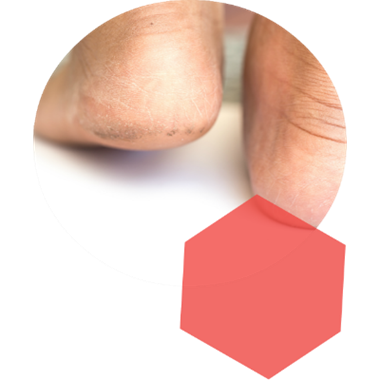Many people suffer from dry skin on their feet. Unlike other parts of our body, the skin on our feet is naturally dry as it has no oil glands, so it relies on thousands of sweat glands to keep it moisturized.
If you don’t moisturize on a regular basis, dry skin on your feet can worsen quickly, becoming unsightly and won’t look healthy and beautiful. It can also become painful and itchy causing discomfort. By removing the old, dead skin and hydrating the new, you’ll soon restore your feet to looking and feeling fabulous.
Recognizing dry skin on feet
Dry skin on feet appears cracked, dry and can sometimes look red and itchy. Usually, the bulk of the dry skin will look white, rather than yellow (which usually indicates a callus). The severity can range from rough, dry skin to painful, peeling or flaking areas and red, itchy patches. Although anyone can suffer from dry skin on feet, you are more likely to suffer with it the older you get. It can appear anywhere on the feet, but most commonly affects the heels, ball of foot and sides of the feet. Although the skin on our feet is naturally dry, there are many things that can worsen it. Some of the most common causes of dry skin on feet include having showers and baths using very hot water, harsh soaps that strip moisture from the skin, cold weather and dry air (for example, when we have heating or air conditioning on), aging and excessive sun exposure. Although symptoms tend to start off mild at first, they can easily worsen and develop into other problems if not treated. Long-term dry skin on feet is more difficult to correct and manage, and you may end up with dry, cracked feet that are painful or even infected, so it’s important that you treat dry skin on feet with a regular foot care routine.
Best tips for softer skin
There are simple steps you can take to keep dry skin on feet at bay, and rehydrate any skin that’s suffering.
- Moisturize your feet daily.
- Wear shoes that allow your feet to breathe, but if wearing sandals in hot weather, remember that dust and heat can dry out your skin, so cleanse and moisturize them well at the end of the day.
- Choose soft, comfy socks, as dry skin on feet is especially sensitive to contact irritants, which can make it drier and itchier.
- Drink plenty of water to keep your skin hydrated, and try to increase your intake of essential fatty acids (found in canola oil, flaxseed oil, walnuts and evening primrose oil), which can help dry skin by decreasing the amount of water lost through the skin’s surface.
- Including the removal of dry / hard skin into your daily beauty regime to prevent a buildup.
- Replace harsh soaps with a product specifically designed for dry feet, which will add moisture.
- After you’ve soaked your feet, moisturize with the Amopé Pedi Perfect™ Daily Moisturizer, and you’ll see a visible improvement.
Using a specially-designed cream which contains the all-important omega-6 and vitamins A and E, or an overnight foot treatment such as the Amopé Pedi Perfect™ Extra Rich Skin Recovery Cream will give your skin a good chance of absorbing moisture and restoring a soft, smooth look and feel.



